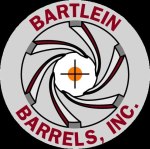Boyer Succeeds with Bartlein Gain Twist Barrel
At the recent IBS 100/200 Yard Nationals, Benchrest legend Tony Boyer shot a spectacular 0.1697 Grand Agg in the Heavy Varmint class (0.1552 at 100, and 0.1843 at 200). This is the combined, distance-adjusted average group size for five targets at 100 yards and five targets at 200 yards. Interestingly, Tony was shooting a very unusual new gain-twist barrel from Bartlein Barrels of Wisconsin. A “gain-twist” barrel has rifling with a variable twist rate, that starts with a slower twist and transitions into a faster twist. The barrel used by Boyer had a very slight gain twist: 1:15″ twist at the breech end, increasing to 1:14.25″ at the muzzle.

Gain twist barrels are nothing new. Barrel-makers in the 19th century experimented with gain twist. More recently, Dan Lilja did quite a bit of testing with gain-twist barrels in the 1980s. However, Lilja concluded that gain twist offers no accuracy advantages: “You get just as good or better accuracy with a standard twist…just as long as the twist remains exactly the same the entire length of the bore.” (See Elements of Accuracy Article.)
 Gain Twist — Does It Offer an Accuracy Advantage?
Gain Twist — Does It Offer an Accuracy Advantage?
Given Boyer’s impressive performance, maybe it’s time to revisit gain twist technology. The theory is that a slower initial twist rate may be “kinder” to bullets as they start to engrave in the rifling. There may be some slight velocity advantages as well.
Frank Green of Bartlein barrels has noted: “Gain twist type barrels have been around forever. It was used a lot back in Pope’s day with the false muzzle loaders shooting lead bullets. A lot of lead bullet shooters and rimfire shooters have asked us to do [gain-twist] barrels for them. Also shooters shooting the new, solid, machined-type bullets with driving bands on them want a gain twist type barrel. Supposedly it’s easier on the driving bands as the bullet enters the rifling. Also in bigger calibers like 20mm the gain twist is used. Mostly because you are starting a very heavy bullet into the barrel.
At Bartlein, we designate gain-twist type rifling as “T” style rifling (“T” for transitional). Why? Simply because we can cut [many variations]: straight conventional-style twist, a very uniform slow gain-type twist, or a radical gain-type twist. We can [create] anything the customer wants. The tooling still plays a part and can effect the cost of the barrel on a gain type twist.
Is gain twist for everyone? At this point in time I would say no still. Also remember, way back when, gain twist type barrels had a radical type gain. The one that Tony and couple of other guys have are not a drastic type gain. The [gain twist barrel] that Tony has only goes from a 1-15 at the breech to 1-14.25 at the muzzle. It didn’t seem to hurt him at all at the Nationals. He picked the twist and we made it for him.
I would agree with the general statement that most gain twist type barrels don’t shoot conventional jacket/lead core bullets well or should I say [they can be] temperamental. However, a slight gain seems to be OK after what Tony did.”
Lou Murdica has been evaluating Bartlein gain-twist barrels with a 1:14″-1:13.25″ twist. Lou won a Benchrest match with a 14-13.25 Bartlein gain-twist in Sacramento convincingly, and Lou told Bartlein that a similar gain-twist barrel on Lou’s railgun has been very accurate and ultra-consistent when tested with a wide variety of bullets. Lou can’t speculate as to why, but the Bartlein gain-twist BR barrels appear to be working extremely well and are not finicky about bullet choice.
Tony Boyer photo courtesy IBS.




















